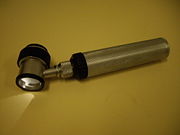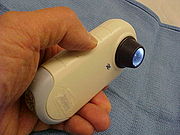
Nevus
Encyclopedia
Nevus is the medical term for sharply-circumscribed and chronic
lesion
s of the skin
. These lesions are commonly named birthmarks and moles
. Nevi are benign by definition. Using the term nevus and nevi loosely, most physicians and dermatologists are actually referring to a variant of nevus called the "Melanocytic nevus
", which are composed of melanocytes. Histologically, melanocytic nevi are differentiated from lentigines
(also a type of benign pigmented macule) by the presence of nests of melanocytes, which lentigines (plural form of lentigo) lack.
for a more complete discussion

 Clinical diagnosis of a melanocytic nevus from other nevi can be made with the naked eye using the ABCD guideline, or using dermatoscopy
Clinical diagnosis of a melanocytic nevus from other nevi can be made with the naked eye using the ABCD guideline, or using dermatoscopy
. The main concern is distinguishing between a benign nevus, a dysplastic nevus
, and a melanoma
. Other skin tumors can resemble a melanocytic nevus clinically, such as a seborrheic keratosis
, pigmented basal cell cancer, hemangiomas, and sebaceous hyperplasia
. A skin biopsy
is required when clinical diagnosis is inadequate or when malignancy is suspected.
can help in differentiation between the benign and malignant lesions.
Chronic (medicine)
A chronic disease is a disease or other human health condition that is persistent or long-lasting in nature. The term chronic is usually applied when the course of the disease lasts for more than three months. Common chronic diseases include asthma, cancer, diabetes and HIV/AIDS.In medicine, the...
lesion
Lesion
A lesion is any abnormality in the tissue of an organism , usually caused by disease or trauma. Lesion is derived from the Latin word laesio which means injury.- Types :...
s of the skin
Skin
-Dermis:The dermis is the layer of skin beneath the epidermis that consists of connective tissue and cushions the body from stress and strain. The dermis is tightly connected to the epidermis by a basement membrane. It also harbors many Mechanoreceptors that provide the sense of touch and heat...
. These lesions are commonly named birthmarks and moles
Mole (skin marking)
A melanocytic nevus is a type of lesion that contains nevus cells .Some sources equate the term mole with "melanocytic nevus". Other sources reserve the term "mole" for other purposes....
. Nevi are benign by definition. Using the term nevus and nevi loosely, most physicians and dermatologists are actually referring to a variant of nevus called the "Melanocytic nevus
Melanocytic nevus
A melanocytic nevus is a type of lesion that contains nevus cells .Some sources equate the term mole with "melanocytic nevus". Other sources reserve the term "mole" for other purposes....
", which are composed of melanocytes. Histologically, melanocytic nevi are differentiated from lentigines
Lentigo
A lentigo is a small pigmented spot on the skin with a clearly-defined edge, surrounded by normal-appearing skin. It is a harmless hyperplasia of melanocytes which is linear in its spread. This means the hyperplasia of melanocytes is restricted to the cell layer directly above the basement...
(also a type of benign pigmented macule) by the presence of nests of melanocytes, which lentigines (plural form of lentigo) lack.
Classification
Epidermal nevi are derived from keratinocytes or derivatives of keratinocytes. Connective tissue nevi are derived from connective tissue cells like adipocyte and fibroblasts. Vascular nevi are derived from structures of the blood vessels. See birthmarkBirthmark
A birthmark is a benign irregularity on the skin which is present at birth or appears shortly after birth, usually in the first month. They can occur anywhere on the skin. Birthmarks are caused by overgrowth of blood vessels, melanocytes, smooth muscle, fat, fibroblasts, or...
for a more complete discussion
Melanocytic nevus
- Congenital nevus implying a melanocytic nevus present at birth or near birth.
- Acquired melanocytic nevusMelanocytic nevusA melanocytic nevus is a type of lesion that contains nevus cells .Some sources equate the term mole with "melanocytic nevus". Other sources reserve the term "mole" for other purposes....
. Implies a melanocytic nevus acquired later in life, and not at or near birth. Most melanocytic nevi are of the acquired variety. - Melanocytic nevusMelanocytic nevusA melanocytic nevus is a type of lesion that contains nevus cells .Some sources equate the term mole with "melanocytic nevus". Other sources reserve the term "mole" for other purposes....
(nevomelanocytic nevus, nevocellular nevus): benign proliferation of melanocyteMelanocyte-External links: - "Eye: fovea, RPE" - "Integument: pigmented skin"...
s, the skin cells that make the brown pigment melaninMelaninMelanin is a pigment that is ubiquitous in nature, being found in most organisms . In animals melanin pigments are derivatives of the amino acid tyrosine. The most common form of biological melanin is eumelanin, a brown-black polymer of dihydroxyindole carboxylic acids, and their reduced forms...
. Hence, most nevi are brown to black. They are very common; almost all adults have at least one, usually more. They may be congenital or acquired (usually at puberty). - Dysplastic nevusDysplastic nevusA dysplastic nevus is an atypical melanocytic nevus; a mole whose appearance is different from that of common moles. Dysplastic nevi are generally larger than ordinary moles and have irregular and indistinct borders...
usually an acquired melanocytic nevus with abnormal features making it difficult to distinguish from a melanomaMelanomaMelanoma is a malignant tumor of melanocytes. Melanocytes are cells that produce the dark pigment, melanin, which is responsible for the color of skin. They predominantly occur in skin, but are also found in other parts of the body, including the bowel and the eye...
. It can be a marker for an individual at risk for developing melanomas.
Epidermal nevus
- Epidermal nevus: congenital, flesh-colored, raised or warty, often linear lesion, usually on the upper half of the body.
- Nevus sebaceus: variant of epidermal nevus on the scalp presenting as a hairless, fleshy or yellowish area.
Diagnosis of nevi


Dermatoscopy
Dermatoscopy is the examination of skin lesions with a dermatoscope...
. The main concern is distinguishing between a benign nevus, a dysplastic nevus
Dysplastic nevus
A dysplastic nevus is an atypical melanocytic nevus; a mole whose appearance is different from that of common moles. Dysplastic nevi are generally larger than ordinary moles and have irregular and indistinct borders...
, and a melanoma
Melanoma
Melanoma is a malignant tumor of melanocytes. Melanocytes are cells that produce the dark pigment, melanin, which is responsible for the color of skin. They predominantly occur in skin, but are also found in other parts of the body, including the bowel and the eye...
. Other skin tumors can resemble a melanocytic nevus clinically, such as a seborrheic keratosis
Seborrheic keratosis
A seborrheic keratosis is a noncancerous benign skin growth that originates in keratinocytes. Like liver spots, seborrheic keratoses are seen more often as people age. In fact they are sometimes humorously referred to as the "barnacles of old age". They appear in various colors, from light tan to...
, pigmented basal cell cancer, hemangiomas, and sebaceous hyperplasia
Sebaceous hyperplasia
Sebaceous hyperplasia is a disorder of the sebaceous glands in which they become enlarged.producing yellow, shiny bumps on the face. These bumps are a natural response to the maternal hormones of pregnancy and usually resolve on their own within a few weeks after delivery.Sebaceous glands are...
. A skin biopsy
Skin biopsy
Skin biopsy is a biopsy technique in which a skin lesion is removed and sent to the pathologist to render a microscopic diagnosis. It is usually done under local anesthetic in a physician's office, and results are often available in 4 to 10 days. It is commonly performed by dermatologists. Skin...
is required when clinical diagnosis is inadequate or when malignancy is suspected.
Normal Evolution or Maturation of Melanocytic Nevus
All melanocytic nevi will change with time - both congenital and acquired nevi. The "normal" maturation is evident as elevation of the lesion from a flat macule to a raised papule. The color change occurs as the melanocytes clump and migrate from the surface of the skin (epidermis) down deep into the dermis. The color will change from even brown, to speckled brown, and then losing the color and becomes flesh colored or pink. During the evolution, uneven migration can make the nevi look like melanomas, and dermatoscopyDermatoscopy
Dermatoscopy is the examination of skin lesions with a dermatoscope...
can help in differentiation between the benign and malignant lesions.
See also
- Becker's nevusBecker's nevusBecker's nevus is a skin disorder predominantly affecting males...
- Dysplastic nevusDysplastic nevusA dysplastic nevus is an atypical melanocytic nevus; a mole whose appearance is different from that of common moles. Dysplastic nevi are generally larger than ordinary moles and have irregular and indistinct borders...
- a melanocytic nevus with abnormal pigment features which can be difficult to distinguish from a melanoma. - List of cutaneous conditions

